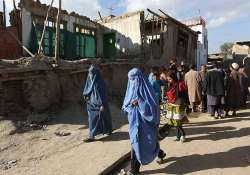Washington: Earthquakes can change elastic properties of the Earth's crust up to 6,000 kilometres away, altering its ability to withstand stresses for up to a few weeks, a new study has found.
The research demonstrates that the Earth is a dynamic and interconnected system, where one large earthquake can create a cascading sequence of events thousands of kilometres away, researchers said.
"Earthquakes can fundamentally change the elastic properties of the Earth's crust in regions up to 6,000 kilometres away, altering its ability to withstand stresses for a period of up to a few weeks," said Kevin Chao, a postdoc in Massachusetts Institute of Technology's Department of Earth, Atmospheric and Planetary Sciences and a member of a research team led by Andrew Delorey at Los Alamos National Laboratory.
When a surface wave from an earthquake some way off passes through another fault region, it changes the balance between the frictional properties that keep the surfaces locked together, the elasticity that allows the crust to withstand strain, and the stress state that can cause it to fail, Chao said.
"When surface waves pass through, all of these properties rearrange and change. If a fault with high stress is ready to fail, it will accumulate more stresses in the fault, meaning an earthquake could occur at any time," Chao said.
In the new research, published in the journal Science Advances, scientists studied the 2012 earthquake off the coast of North Sumatra in the Indian Ocean.
The earthquake, which had a magnitude of 8.6, is known to have been followed by two earthquakes in Japan with a magnitude greater than 5.5.
The researchers studied data from strain metre readings, GPS equipment, and information on seismicity -- or the number of small-magnitude earthquakes -- in the region, as well as the migration of the earthquakes.
They found that the two triggered quakes with a magnitude of greater than 5.5 were part of a cluster of activity in the area in the days after the Indian Ocean event.
"When the Indian Ocean earthquake occurred, the surface wave passed through the northeast of Japan, and the seismicity in the region was suddenly triggered," Chao said.
This region of the Earth's crust was already critically stressed following the major Japanese earthquake of 2011, so the additional stress, albeit temporary, caused by the surface wave passing through, was enough to trigger another cluster of quakes.
When a fault fails and an earthquake occurs, it also pushes into the neighboring region, reducing the available space and compressing the crust in this area.
So the researchers also looked for signs of compressive stress in this region of Japan following the Indian Ocean earthquake. They found signs that cracks in the rock under the Japanese mainland were closing as a result of compressive stress, increasing the shear strength of the crust.
Latest World News
